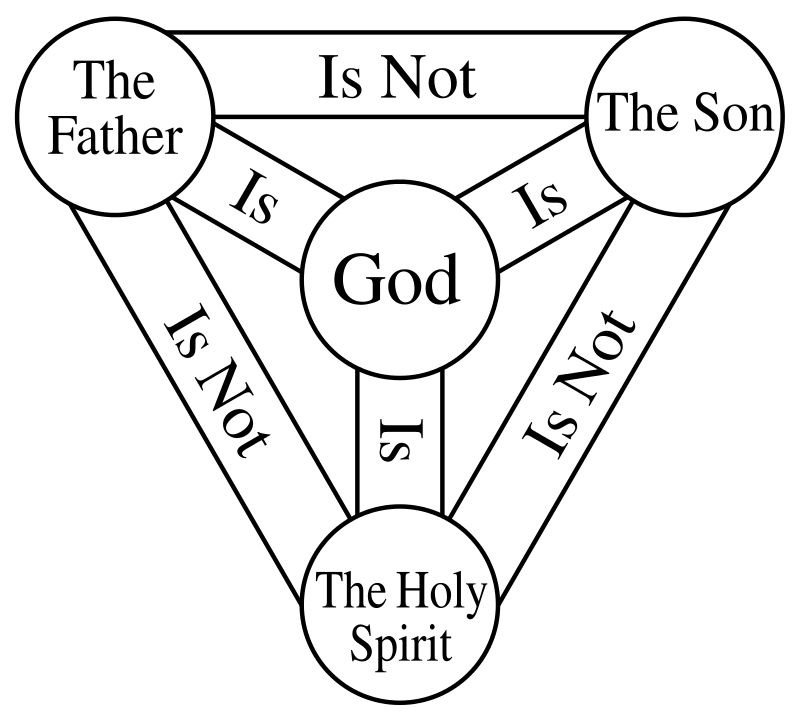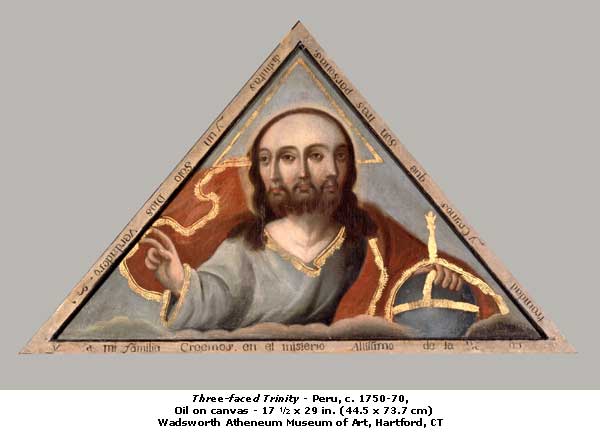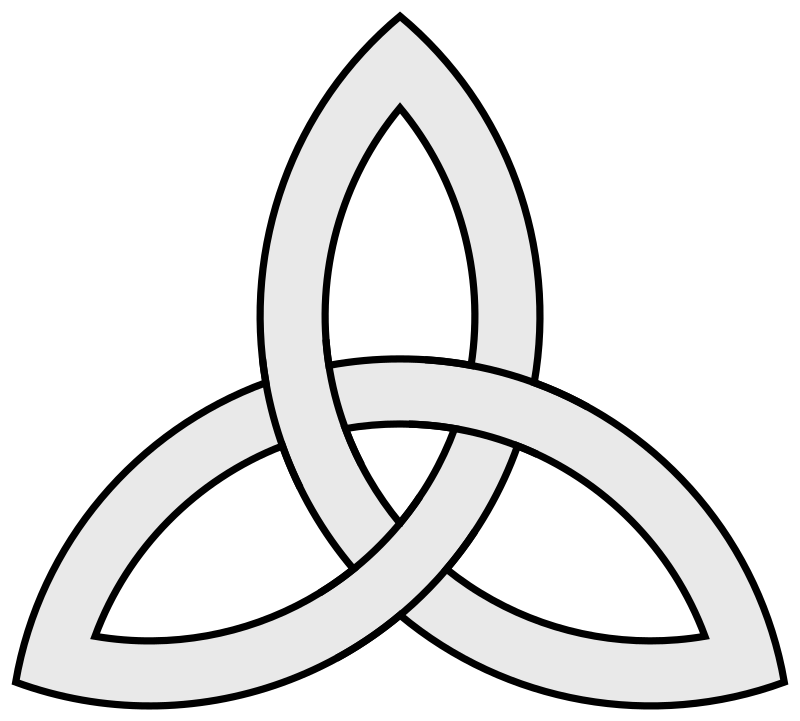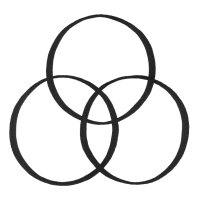The Hebrew Ruach HaKodesh vs the Roman Holy Spirit
The Hebrew Ruach HaKodesh and the Roman Holy Spirit are two different concepts of the power of the Creator; the former sees Ruach HaKodesh as the creative force, the power of the Creator through which everything came into existence, while the latter sees it as the “third person” of the “Holy Trinity”: The Father, the Son, and the Holy Spirit, three persons in one God, all Gods, yet they are one God. In this trinitarian formula, which appears only in Mat 28:19 but lacking in the other gospels, all Christian scholars agree that the first person, the Father, is Spirit, the second person is the body of the “trinity”, and the third person is Holy Spirit, that is, a special Spirit. But who is able to define the term “person” in reference to the Creator, because neither the Tanak nor the Apostolic Writings define the Creator and His Ruach HaKodesh as “persons”? In Hebrew, there is only one term for a person—nephesh chayah, living soul—which refers only to humans. Also, the Father and the Son have names, but what is the name of Ruach HaKodesh, if Ruach HaKodesh is a “person” and not the creative force of YHVH?
This study has no intention and is unable to define the infinite Creator YHVH, for who could be able. Nor will it pretend to give exhaustive answers to these and other questions, for who is able? This study is a further development of the series of articles dedicated to this controversial subject: “Mystery of Origin of Life“, “Virgin Birth of the Messiah—the Mystery of Life“, and “The Oneness of the Creator“. In them we studied the process of creation of life and the role Ruach HaKodesh (aka the Holy Spirit) plays in it.
We noted that YHVH the Creator through His creative power—Ruach HaKodesh—formed man from the dust, and He breathed His Breath of life—Neshamah—and a living being—nephesh chayah—was created (Gen 2:7). Thus, Ruach HaKodesh (aka “Holy Spirit”) and the Neshamah (the Breath) of YHVH are both the creative forces of the Power (Elohim) of the Creator YHVH. United as One, echad, in YHVH, Ruach HaKodesh and the Neshamah are the Absolute Powers (Elohim) of YHVH. In other words, this creative fullness of the Oneness of YHVH is revealed in the creation through Ruach HaKodesh and His Neshemah, the Breath of life. They both radiates from Him and together they are the combine forces of the One YHVH. But neither of them has ever been called a “person” in the Scripture.
In this study we will continue to study Ruach HaKodesh (the Holy Spirit), the so-called “the third person” in “the Trinity” without adding anything to the Word of YHVH, which is forbidden to start with.
Ruach HaKodesh — the Wind of Separation
As we noted in a previous article, Ruach of the Creator literally means “wind”. This Wind is seen in action as early as in the creation of the world and the creation of the first week.
The Day One of creation (Gen 1:3-5) is the separation of light and darkness which were filled with substance (the sun and moon, and the celestial bodies) on the fourth day (Gen 1:14-19).
The second day (Gen 1:6-8) is the separation of the water and the heavens which were filled with substance (fish and birds) on the fifth day (Gen 1:20-23).
The third day (Gen 1:9-13) is the separation of water and dry land which were filled with substance (animals and man) on the six day (Gen 1:24-31) .
And ultimately, the seventh day, the Sabbath Day of the Creator (Gen 2:1-3) is the separation of this special day of the creation from the other days of the creation week in which He completed His work and rested.
The common element in the first week of reckoning of time is the word separation represented in Hebrew by the word kodesh, commonly translated “holiness”. In Hebrew, separation is קֹדֶשׁ kodesh, a sacred place or thing; saint, sanctuary, a set-apart one separated for special purposes. The noun kodesh comes from the root verb קָדַשׁ kadash, to appoint, consecrate, dedicate, set apart, and separate. And indeed, from the creation week we understand that the Creator YHVH appointed and set apart, that is, separated each day for a certain work of His creation. The literal meaning of kadash can be seen in the dedication of the seventh day, the Sabbath, as a special day to YHVH (Gen 2:3). Thus, we see that the Sabbath day was dedicated, set apart, separated from the rest of the days as a special day. A word derived from kodesh is מִקְדָּשׁ mikdash, and means a consecrated thing or place, especially referring to the dwelling place of YHVH among His people: The Tabernacle and the Temple in Jerusalem (Exo 15:17, Exo 25:8). Kadash, however, can have a negative meaning to defile, as seen in the command not to mix seeds of a different kind, which, in modern-day terms, is a prohibition of genetic engineering,
Do not sow your vineyard with different kinds of seed, lest the yield of the seed which you have sown, and the fruit of your vineyard be defiled (kadash). (Deu 22:9)
From this meaning of kadash, to defile, another very negative word is derived: קָדֵשׁ kadesh, a male devotee (by prostitution), a male cult prostitute (1Ki 14:24, 1Ki 15:12, 1Ki 22:46, 2Ki 23:7), and its feminine form קְדֵשָׁה kedeshah, a female devotee, a females cult prostitute, harlot, whore (Deu 23:17). This exact Hebrew word, kodesh, is translated “holy” as in “holy spirit” in the Bibles. However, such a translation brings a grammatical issue.
In the non-Hebraic languages, the word “holy” is an adjective describing the word “spirit”, i.e. “holy spirit”. In the Hebrew, however, the word kodesh is a noun (as the word ruach, wind or breath), not an adjective, which prevents kodesh from using it as an adjective, and therefore, both nouns ruach hakodesh should be translated as such. Moreover, the prefix ha “the” designates kodesh as a noun. The other grammatical issue is that ruach is feminine, while kodesh is masculine. Unlike English, Hebrew has masculine and feminine genders, singular and plural forms for the nouns, verbs, and adjectives, and they all must be in agreement. For instance, if the subject of the sentence is a feminine singular, the verb and the adjective must also be in that form. Therefore, ruach hakodesh translated as “holy spirit” creates a grammatical problem in Hebrew.
Note: In Hebrew the adjective is not what adjective is in the other languages, but simply put, a form of a noun.
Another possible translation of Ruach HaKodesh is “Wind of the separation” as kodesh can mean “set-apartness” and “separation”. But if we translate, Ruach (noun) HaKodesh (noun), as the Wind of the Set-apart One, or the Wind of the separation, all problems are eliminated, because by His Ruach HaKodesh, the Set-apart One separated matter, time, and space to create the first week of creation. And indeed, Ruach HaKodesh is the Wind of YHVH who exists beyond time and space, i.e. the One who is separated from this world. And the literal meaning of the Creator Yehovah is “He who exists forever”.
As we studied in the aforesaid article, if we understand Ruach HaKodesh in the pattern of the menorah (see Isa 11:2, Rev 4:4-5), then we will see that the Wind of the separation separates the three pairs of the winds (ruchot) of YHVH:
- the Ruach of wisdom and understanding,
- the Ruach of counsel and might,
- the Ruach of knowledge and of the awe of YHVH.
And we studied that the Creator YHVH has seven ruchot, “spirits”, but still retains oneness. These ruchot of counsel, might, wisdom, understanding, knowledge and awe, are really the powers of the Ruach of YHVH, yet He is One. The Ruach of YHVH refers to the supernatural aspect of creation (Gen 1:2), prophecy, wisdom, knowledge and understanding (Isa 11:2). It also refers to the heavenly force, quality, and influence of YHVH, over the universe and over His creatures, in the corresponding contexts. The best analogy of the Oneness of the Creator is the prism that separates the white light into seven colors (Job 38:24), yet, it is still one light.
Where is the way that light is divided, or the east wind scattered over the earth? (Job 38:24)
Ruach HaKodesh of YHVH as His Power
And Yehovah stirred up the spirit of Zerubbavel son of She’alti’el, governor of Yehudah, and the spirit of Yehoshua son of Yehotsadak, the high priest, and the spirit of all the remnant of the people. And they came and worked on the House of Yehovah of hosts, their Elohim, (Hag 1:14)
This promise of rebuilding His Temple, YHVH fulfilled by giving to Zerubbavel, Yehoshua (Joshua), and the people, the strength to carry out the work by awakening the spirit (wind, breath) of man to make him willing and able to carry out the work. Thus, filled with joyfulness, courage, and strength, they began the work on rebuilding the Temple of YHVH in Jerusalem. Another example of the Ruach as the Power of YHVH in action is seen in the prophecy in Micah,
But truly I am filled with power, with the Spirit of Yehovah, and with judgement and with might, to declare to Ya’akov his transgression and to Israel his sin. (Mic 3:8)
In Mic 3:8, the prophet contrasts himself and his own deeds with the false prophets, as being filled with koach, power, with judgment, mishpat, and with might, gevurah, strength, to hold up the Power and Ruach of YHVH, with the justice and might. In this heavenly given strength, the prophet declared the unrighteousness of the people and the punishment that would come from Him. In this passage, the Hebrew word כּוֹחַ koach, power, comes from a root meaning to be firm and vigor, literally force, used in a good or a bad sense. We find its literal meaning in passages such as Exo 9:16, Exo 15:6, Exo 32:11, Num 14:17, Gen 49:3, and Psa 29:4, where koach is translated as “power”. The second word in question is גְּבוּרָה gevurach, a feminine form of גִּבּוֹר gibor, powerful; by implication warrior, mighty one, strong man. Thus, gevurah means force, literally or figuratively, might, power, strength. Together, Ruach Yehovah, coupled with Koach, and Gevurah of YHVH the prophet was filled with, bring the idea of the Power that comes from Him. As noted before, the seven Ruchot (winds) of YHVH that would rest upon His Messiah (Isa 11:2), where one of these Ruchot of YHVH is the Ruach of might, i.e. gevurah. For more knowledge of the seven Spirits of YHVH, after whose manner the seven-branch menorah of the Temple was designed, refer to the aforesaid articles.
The Holy Spirit of YHVH in the Apostolic Writings
The Ruach HaKodesh (the Wind of the Set-apart One) shall come upon you, and the Power of the Most High shall overshadow you. And for that reason HaKodesh (the Set-apart One) born of you shall be called: Son of Elohim. (Luk 1:35)
The creative Power, Ruach HaKodesh (the Holy Spirit), of YHVH shaped this miracle of the Word that became flesh (Joh 1:1-3). The appearance of the Seed of the woman (Gen 3:15) among mankind was a direct act of Ruach HaKodesh and the Neshamah of YHVH in the coming of the Seed who voluntarily emptied Himself from His own transcendent nature and came to be in the likeness of man, of which the apostle spoke (Php 2:7). That was the real fusion of Ruach HaKodesh and the Neshamah of YHVH that created the human form of the transcendent Son of Elohim.
In Luk 1:35, we find that Ruach HaKodesh (the Holy Spirit) is the power of the Most High, clearly revealed in the parallelism: The Set-apart Spirit shall come upon you, parallels with and the power of the Most High shall overshadow you. And for that reason (of coming of Ruach HaKodesh, i.e. the Power of Elohim, not for any other reason) the Set-apart One born of you shall be called: Son of Elohim (literally the Son of the Absolute Power). And more,
And Yeshua returned in the power of the Ruach (Spirit) to Galil, and news of Him went out through all the surrounding country. (Luk 4:14)
But you shall receive power when the Set-apart Spirit has come upon you, and you shall be My witnesses in Jerusalem … (Act 1:8)
how Elohim did anoint Yeshua of Natsareth with the Set-apart Spirit and with power, who went about doing good and healing all who were oppressed by the devil, for Elohim was with Him. (Act 10:38)
who was designated Son of Elohim with power, according to the Set-apart Spirit, by the resurrection from the dead: Yeshua Messiah, the Master of us, (Rom 1:4)
And the Elohim of hope fill you with all joy and peace in believing, that you overflow with hope by the power of the Set-apart Spirit. (Rom 15:13)
in power of signs and wonders, in power of the Spirit of Elohim, … (Rom 15:19)
And my word and my preaching were not with persuasive words of man’s wisdom, but in demonstration of the Spirit and of power, (1Co 2:4)
in order that He might give you, according to the riches of His glory by power, to be strengthened in the inner man, through His Spirit, (Eph 3:16)
Because our Good News did not come to you in word only, but also in power, and in the Set-apart Spirit … (1Th 1:5)
With that being said, from these quick quotes from the Apostolic Writings we plainly see that Ruach HaKodesh (the Holy Spirit) is nothing else but the power of YHVH in action. Ruach HaKodesh (the Wind of the Separation) has never been identified as a “person” or something else, but as the power of the Most High. But where has the term “person” come from?
In the Roman theater, the characters were played by male actors, who put masks on their faces to depict different states of sadness, gladness, anger, etc. Such a face mask employed by a Roman actor is called “persona”, hence in English: “person”. The Roman Church and her sister-church the Eastern Orthodox Church plainly call the Creator of the universe, Trinity, which in their doctrine means three Gods: God the Father, God the Son, and God the Holy Spirit. These three Gods are distinct from each other: God the Father is not God the Son, God the Son is not God the Holy Spirit, and God the Holy Spirit is not God the Father (see the illustration below). While this is an outright polytheism and idolatry, the protestant churches adopted this theology by just changing the veneer. However, in the 20th century America the so-called “evangelical” churches admitting that this was a pure form of paganism decided to change the veneer even further and started to call the Trinity, “Triunity”, i.e. “a triune God”. They replaced the three Gods of the Catholicism with “three persons” of the Protestantism upon the face of the Eternal. And this is how the Second Commandment of the Covenant translates literally,
You shall have no gods of the others upon My Face. Exodus 20:3
The intelligent reader will understand it.
The “Holy Spirit” in the Christian theology
In all branches of Christianity, Ruach HaKodesh, “Holy Spirit”, is believed to be the third consubstantial person of God and part of the “Holy Trinity”. For the Christians, the Holy Spirit (or Holy Ghost, from Old English gast, “spirit”) is the third member of the “Triune God” manifested in three persons as the Father, the Son, and the Holy Spirit: each person being a deity. The word spirit is of Latin origin, spiritus, i.e. Spiritus Sanctus, “Holy Spirit”. It is worth noting here again that there is a grammatical difficulty of translating Ruach HaKodesh as “Holy Spirit”, namely that in the trinitarian formula the word “holy” is an adjective and “spirit” is a noun, while in Hebrew the term Ruach HaKodesh is two nouns.
As noted above, the Hebrew Scripture contains the term Ruach HaKodesh in the sense of the might and power of YHVH. But this meaning is different from the Christian concept of “Holy Spirit” as a person in the “holy trinity”.
Note: The “trinitarian” formula, as found in Mat 25:19-20, is not present in the ancient text of Hebrew Gospel of Matthew (aka Hebrew-Shem Tov Matthew), which simply reads, “Go and teach them to carry out all things which I have commanded you forever” (Mat 28:19). Not found in the Hebrew Shem-Tov text is, “…and make disciples of all the nations, immersing them in the Name of the Father and of the Son and of the Set-apart Spirit”. Shem-Tov agrees with Act 2:38, Act 10:48, Act 8:16, Act 19:5, Gal 3:27, and Rom 6:3, in which verses the baptism is in the Name of Yeshua the Messiah. The “trinitarian formula” “… in the Name of the Father and of the Son and of the Set-apart Spirit” formula appears only in the canonical Greek and lacking in Shem-Tov, other early Greek codices such as Codex Sinaiticus, Old Syriac and Old Latin. This has led the scholars to believe that the “trinitarian” formula is an interpolation into the text.
The concept of the “Holy Trinity” therefore as three persons in one is problematic or at least polemic from Hebraic perspectives, unless someone is able to define the term “person” in reference to the Creator.
“Faith did not change Rome; Rome changed the faith”
The Christian concept of the Holy Spirit cannot be explained from Hebraic perspectives alone without reference to the heathenish religions. We will conclude with quotes from The Two Babylons by Reverend Alexander Hislop, first published as a pamphlet in 1853 and greatly expanded in 1858, Chapter II Objects of Worship, Section I Trinity in Unity.
“In the unity of that one Only God of the Babylonians, there were three persons, and to symbolise that doctrine of the Trinity, they employed, as the discoveries of Layard prove, the equilateral triangle, just as it is well known the Romish Church does at this day. *
* LAYARD’s Babylon and Nineveh. The Egyptians also used the triangle as a symbol of their “triform divinity.”
In both cases such a comparison is most degrading to the King Eternal, and is fitted utterly to pervert the minds of those who contemplate it, as if there was or could be any similitude between such a figure and Him who hath said, “To whom will ye liken God, and what likeness will ye compare unto Him?”
Few Christians know that the original doctrine of the “Holy Trinity” was “the Father, Mary, and their Son” established by the Nicene Council of the Catholic Church. We read further in “The Two Babylons”,
“Is there one, who fears God, and who reads these lines, who would not admit that Paganism alone could ever have inspired such a doctrine as that avowed by the Melchites at the Nicene Council, that the Holy Trinity consisted of “the Father, the Virgin Mary, and the Messiah their Son”? (Quarterly Journal of Prophecy, July, 1852) Is there one who would not shrink with horror from such a thought? What, then, would the reader say of a Church that teaches its children to adore such a Trinity as that contained in the following lines?
“Heart of Jesus, I adore thee;
Heart of Mary, I implore thee;
Heart of Joseph, pure and just;
IN THESE THREE HEARTS I PUT MY TRUST.”
Reverend Alexander Hislop continues,
“The Papacy has in some of its churches, as, for instance, in the monastery of the so-called Trinitarians of Madrid, an image of the Triune God, with three heads on one body. The Babylonians had something of the same. Mr. Layard, in his last work, has given a specimen of such a triune divinity, worshipped in ancient Assyria.”
The symbol of the “Holy Trinity” well accepted in the Christianity is the so-called “triquetra”; from the Latin adjective triquetrus, three-cornered. Triquetra denotes a shape formed of three leaf-like shapes in between three equal-diameter circles, symbolizing the Father, the Son, and the Holy Spirit, each centered on the circumference of the other, sometimes with an added circle in or around the three lobes. Triquetra is also known as a “Trinity Knot” and its design is used as a religious symbol adapted from ancient Pagan Celtic images by Christianity. It is similar to the “valknut”, a Norse symbol.
“Will anyone after this say that the Roman Catholic Church must still be called Christian, because it holds the doctrine of the Trinity? So did the Pagan Babylonians, so did the Egyptians, so do the Hindoos at this hour, in the very same sense in which Rome does. They all admitted A trinity, but did they worship THE Triune Jehovah, the King Eternal, Immortal, and Invisible? And will anyone say with such evidence before him, that Rome does so? Away then, with the deadly delusion that Rome is Christian!”
We should ask ourselves the question, “If YHVH punished the Israelites who ignorantly made an image of Him having broken the Second Commandment of the Covenant, why should He overlook these pagan images of unholy spirits, which the Church deliberately adopted?”
Whether the Creator is “trinity” the present author does not know. Who has seen Him and is still alive? But what he knows is that there is no such term in the Scripture; even more, there is no such a Hebrew word in the Scripture that depicts such a concept. If there is a human being who had ever known the Oneness of the Creator, that was Mosheh. He was the only human being who had ever known the Creator so closely, to speak with Him mouth to mouth and face to face, yet, he simply said, “Listen up O Israel, YHVH is one!” It is up to the reader to decide, but while the judgement is entirely His, the warning is ours.
Knowledge known to only a few will die out. If you feel blessed by these teachings of Time of Reckoning Ministry, help spread the word!
May we merit seeing the coming of our Mashiach speedily in our days!
This page contains sacred literature and the Name of the Creator. Please, do not deface, discard, or use the Name in a casual manner.






